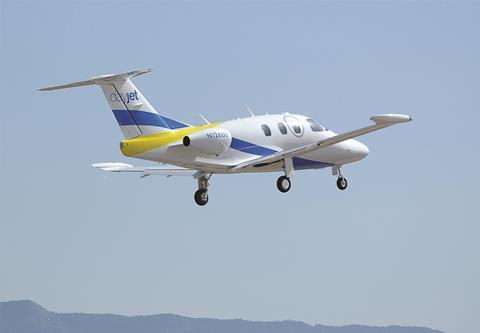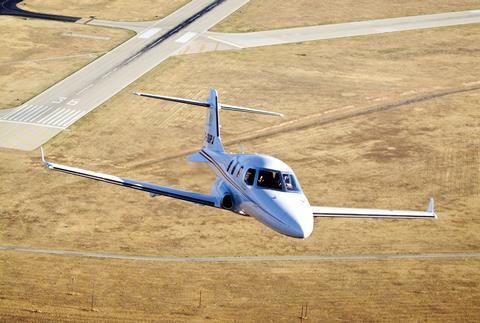Would-be disruptors determined to broaden access to private aviation with a new category of more affordable and greener aircraft they are sure will sell in the thousands – and with orders aplenty from early adopters. It might sum up the anticipation today around advanced air mobility (AAM) but, rewind two decades, and it also describes the nascent very-light jet (VLJ) market.
Spearheaded by Vern Raburn’s Eclipse Aviation, the segment embraced other new names such as Adam Aircraft, as well as established players Cessna, Cirrus, Diamond, and Piper. They believed their clean-sheet VLJs could fill the gap between high-performance piston types and existing light jets and grow the market by attracting air taxi start-ups and others new to aviation.

It never lived up to the promise, though there were successes. Cessna, which had been making light jets since the 1960s, delivered almost 500 Mustangs from 2006 to 2017, when parent Textron Aviation ended production as demand tilted to the larger M2. Honda Aircraft’s HondaJet and Embraer’s Phenom 100 have also been described as VLJs, although, based on cabin size and range, they are perhaps more accurately light jets.
There were plenty of ‘never-quite-made-its’. The 2008 financial crisis saw the demise of Adam Aircraft, along with its A700 design. Two other new ventures, VisionAire with the Vantage, whose original design dates from the 1990s, and Stratos Aircraft which makes the 716X, have flown prototype VLJs – Stratos is currently amid a flight-test campaign – but have yet to reach certification or production.
Two of the most respected general aviation manufacturers, Austria’s Diamond and US-based Piper, made it as far as formally launching single-engined VLJs, prototypes of which they exhibited at shows in the late 2000s and early 2010s. But the D-Jet and the PiperJet Altaire were axed early in the certification effort because of lack of demand and funding.

The only example of the new breed of entry-level jets that has proved an undisputed winner has been the Cirrus SF50 Vision Jet, which like the original Eclipse 500, is a recipient of the prestigious Collier Trophy.
Powered by a single Williams International FJ33, the type marked its 500th delivery in 2023 after seven years of production and remains the sole live single-engined business jet programme.
As for Eclipse, it has not quite gone away. After Eclipse Aviation’s demise, the Albuquerque firm that was the brainchild of one-time Silicon Valley executive Raburn was born again in 2009 as Eclipse Aerospace, later merging into One Aviation. In 2018 it went bankrupt again before being rescued in 2020 by the AML investment firm of British businessman Christopher Harborne.
Last year, many were surprised when General Aviation Manufacturers Association figures showed two Eclipse 550 deliveries in the first quarter, the first acknowledged shipments since 2017. While this appears to be a one-off – most likely handovers of examples built before the 2018 bankruptcy – Eclipse has been dropping hints about building the twinjet again.
Eclipse executives are attending EBACE and while – in response to enquiries from FlightGlobal – executive vice-president Jeffrey Rochelle says: “We are not doing media or press releases at the present time”, he describes himself in his LinkedIn profile as “building the next generation of low-cost, low-carbon jet mobility”.
The Eclipse 500 still has its fans. Around 250 examples of the Pratt & Whitney Canada PW610F-powered twinjets were produced between 2006 and 2008, followed by around 35 of its Eclipse 550 successor from 2014 to 2017. Almost all remain in service, most of them in the hands of a loyal band of owner pilots.
There are, however, some fleet operators, including Channel Jet, based in the British Crown Dependency of Guernsey, just off the French coast. Founded in 2017 by David Hayman, who previously ran Eclipse sales for Europe, the company currently manages three Eclipse 500s on behalf of Channel Islands-based owners and offers them for charter on a Guernsey air operator’s certificate.
Channel Jet describes its ethos as “shattering the illusion that all private jet travel is for the uber-wealthy”, stressing its service is an “affordable” jet air taxi service for as few as two passengers. Customers tend to be Channel Island residents or property owners travelling to other islands or “near Europe” for business, or to Mediterranean resorts for leisure. “We do a lot of flying into Biggin Hill. London is a strong market,” says chief operating officer Nigel Moll.
The service has been a success in terms of introducing new customers to charter, says Moll. Because of that – and the lack of availability of out-of-production Eclipse jets – the company is now looking to broaden into larger aircraft. “Once people come into the market, they start wanting something bigger, so we are looking at diversifying the fleet,” he says.
Other companies are benefiting from Eclipse’s enduring popularity with owner pilots, which has always been the brand’s core market. They include brokerage Aerocor, based near Las Vegas. The company specialises in VLJs and light jets, facilitating 35 sales last year, including 23 Eclipses, more than seven in 10 of all those that changed hands. “We dominate the space in a way no other broker has been able to,” says co-founder Gavin Woodman.
Aerocor identified the Eclipse market as “under-served” when it was established in 2017, largely because the aircraft was out of production and receiving limited factory support, but also because the fleet of fewer than 300 in-service aircraft meant it was “not going to attract big competitors”, says Woodman. “We saw an opportunity to fill a blank.”
He says Aerocor “helps clients with every aspect of the transaction”, including sourcing pilots, and arranging parking and insurance. It recently launched a management arm and manages two aircraft on behalf of owners. It also offers Eclipse training, reporting a 20% increase in volumes during 2023 thanks partly to “new and younger pilots stepping into the Eclipse space”.
So, what of other VLJ projects in development? Redmond, Oregon-based Stratos Aircraft remains committed to bringing the Stratos 716X to market, although it is “not disclosing” a timescale, nor yet taking formal orders, says chief executive Carsden Sundin. Stratos has flown around 300h on the P&WC JT15D-5-powered jet, after notching up about 500h on an earlier, similar, but slightly smaller proof-of-concept prototype, the 714.
“We anticipate that in about a year from now we will be able to disclose a lot more,” says Sundin, who maintains that the success of the Vision Jet proves there is an appetite for single-engined jets. “It’s unquestionable that there is a market there,” he says. However, Stratos says it is pitching the four-passenger 716X, in terms of size and performance, more against twin-engined types such as the Phenom 100 and HondaJet.
Despite the uncertainty over its certification timetable, Stratos continues to exhibit the 716X – launched in 2018 and which flew for the first time in July 2020 – with its next appearance scheduled for this July’s AirVenture in Oshkosh. The aircraft features a Garmin G3X flightdeck and its cabin is 1.2m (4ft) wide and 1.45m high. The certificated version could see the JT15D-5 replaced with a more modern PW535E engine, also from P&WC.
Less is known about VisionAire’s prospects. The Hickory, North Carolina-based outfit was formed in 2010 to resurrect the Vantage, a 1,500nm (2,800km)-range aircraft designed by Burt Rutan in the 1980s. Larger than the 716X, but also powered by a single engine, the Williams International FJ44-3AP, the jet has still not flown, although an earlier proof-of-concept prototype notched up more than 500h before the original company’s demise in 2003.

Diamond’s D-Jet, which first flew in 2006, is another single-engine design that has not officially been abandoned. In its heyday, before the 2008 financial crash, Diamond notched up dozens of significant orders and established a production facility at its subsidiary in London, Ontario. However, after years of uncertainty, the programme was suspended in 2013 following a failure to secure a Canadian government loan.
In 2018, the airframer’s chief executive Frank Zhang, installed by the company’s new Chinese owner Wangeng, noted that “it would be great to add a jet to our line-up at some point, and with the D-Jet the opportunity is there”.
However, with Diamond’s focus very much on developing electric- and hybrid-electric variants for the training market, the chances of the Williams International FJ33-4A-powered type earning a reprieve look slim.


























